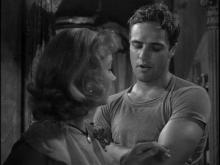The movie A Streetcar Named Desire came out 60 years ago this year. Tennessee Williams’ masterpiece tells the story of the dysfunctional family of Blanche, Stella, and Stanley. Williams, gaining inspiration through the works of Chekhov and others, created a truly innovative play that shocked audition and changed theater forever. Perhaps this is why theater critics deemed A Streetcar Named Desire the best play of the 20th century.
Williams’ play, full of violence and madness, is a modern day classic. It tells the story of Southern belle Blanche who goes to visit her sister Stella and Stella’s husband Stanley. Throughout the show, Blanche teeters on the verge of insanity. She finally falls over the edge when Stanley, convinced Blanche was trying to swindle he and his wife, rapes her. Williams didn’t romanticize any of the characters in the show. All of his blue collar characters are true to life. They are people with a lot of things to think about.
The play opened on Broadway on December 3, 1947. After the play finished, the audience didn’t know how to react. First, they sat in silence. Then, they gave it a standing ovation for a full thirty minutes.A thirty minute standing ovation was an amazing reaction to such a revolutionary play. Like his earlier works, such as The Glass Menagerie, Williams employed nontraditional theater techniques such as unique lighting and music to portray the character’s inner turmoil or memories. Blanche’s descent into madness was illustrated onstage by polka music, jungle sounds, and shadows.
The frankness of the way Williams presented Blanche’s rape and sexuality in general shocked and thrilled audiences. Never in theater or on-screen had sexuality been presented so frankly. Some were thrilled by this. Others, like the Catholic Legion of Decency, wanted to condemn the eventual film version if sexual scenes weren’t removed.
The scandal surrounding the Broadway version soon created a movie version of the play. Many of the same actors, such as Kim Hunter as Stella and Marlon Brando as Stanley, returned to reprise their roles onscreen. Jessica Tandy, Broadway’s Blanche, was replaced by Vivien Leigh, who eventually went on to win an Oscar for the role.
Many historians and Williams’ own brother believe Williams wrote Blanche and Stanley to represent his own life. Historians believe Williams modeled Stanley off of his lover at the time, Pancho Rodriguez Gonzalez. Williams’ brother Dakin said Blanche reminded him of Tennessee.
Tennessee Williams was truly a Southern American original. He drew inspiration from Anton Chekhov, who, like Williams, presented lonely characters and an intertwining of humor and tragedy. Williams was also influenced by D.H. Lawrence who presented the theory that sexuality was an important force in life. Even though he drew inspiration from sources outside of America, William’s characters and settings are truly American.
Williams worked a long time on A Streetcar Named Desire. He made many revisions. The show’s title went from The Moth, to Blanche’s Chair on the Moon, to The Poker Night, and finally to A Streetcar Named Desire. William’s was eventually rewarded for his hard work with New York’s Critic Circle Award and a Pulitzer Prize.
